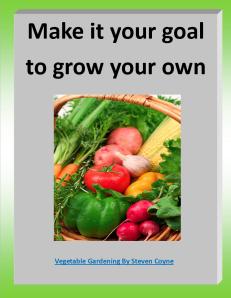 You need to make a choice whether or not to stake or cage your tomatoes, but you need to understand the pros and cons to each side of the issue. Who do you listen to when asking the question of staking or caging your tomatoes?
You need to make a choice whether or not to stake or cage your tomatoes, but you need to understand the pros and cons to each side of the issue. Who do you listen to when asking the question of staking or caging your tomatoes?Everyone has an opinion, so I’m going to give you practical experience gained over the years using both staking and caging, or just letting them grow on the ground.
On the ground:
Let’s start off with just letting them grow on the ground. This method of growing your tomatoes uses up a lot of your garden planting area, especially indeterminate varieties that will grow from 6 to 10 feet tall. They will cover a lot of ground and you may not have the room to allow this. Your plants may become easily attractive to many more ground dwelling insects than they would if they were staked or caged.
It may be a little more difficult to fertilize properly with vines trailing across the garden. You need to get the fertilizer into the root zone and if you don’t remember where it is, you may miss the mark. Place a small stake near the planted area if you grow your tomatoes on the ground to give you an idea where the root zone is and to help you know where your fertilizer should be applied.

Staking:
Staking tomatoes can create problems because you need to keep an eye on your plants on a regular basis to avoid missing tying up wandering new stems and branches. Staking consumes time each day that you must commit to the plants.
As with caging, staking saves a lot of space by keeping your plants up off of the ground. This also allows you to plant more plants because it saves space. Planting more plants close enough together also helps to shade the ground, acting as a living mulch. The tomatoes are so much easier to pick because the plant stands upright. There won’t be as much bending and stooping.
When you force a tomato plant to grow in an upright position, you’ll find some disadvantages as well. The fruit will be more susceptible to problems, because the plant is now growing differently than what is normal, that expose the fruit to the elements. Sunburn is now a possibility. Cracking of the fruit can happen now because the fruit is exposed to winds and the fruit now have a better chance to get blossom end rot.
It’s best to mulch your staked tomatoes heavily. With the plant standing all alone (with a single planting), the likelihood of losing moisture from unprotected soil is far greater. There are a variety of great reasons to mulch your plant(s) anyway, but the best is moisture retention. Tomatoes are water lovers. If you can reduce the amount of money spent on water, but keep the plants evenly moist, you’ll produce good looking and tasting tomatoes.
Drive a stake at least 12” into the ground. Plant tomatoes that are a minimum of 6” tall, and remove all but the top 2 sets of leaves. Cover the stem all the way up to the underside of the first set of leaves and lightly pack the soil around the stem. Once the plant is tall enough, start tying the stems to the stake. With determinate tomatoes, you do not need to remove sucker growth. When staking an indeterminate tomato, you should remove all sucker growth.

Caging tomatoes:
There are almost as many different types of cages on the market as there are tomato varieties out there. From simple 6” wire mesh cut to attain a diameter of 3’, to a fancy stackable and foldable cage that can be purchased online, the gardener has a lot to choose from.
No matter what you choose to cage your tomatoes, make sure that you securely stake the cage to the ground. By doing this, you will help keep the plant and the cage upright in heavy winds.

As with staked tomatoes, you should mulch heavily with something like wheat straw to help retain moisture. Wrap the first two feet of the cage in clear plastic.
This will increase temperatures around the plant and protect it from damaging winds in the early stages of the plants life, and it will help to heat up the area around the new plants when you plant in early spring.









































